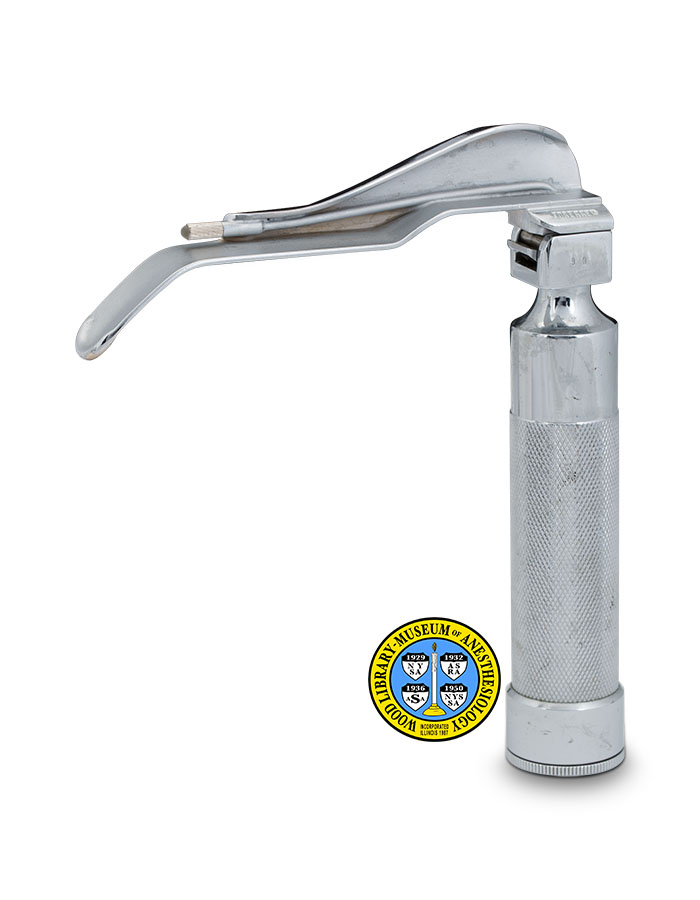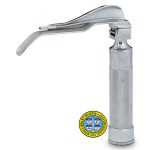Gabuya Laryngoscope
Anesthesiologists are responsible for maintaining the patient's respiration during surgery, and employ a variety of tools for this. A laryngoscope is used to help insert a breathing tube between the vocal cords, through the patient's larynx (voice box) and into his trachea (wind pipe.)
Louis R. Orkin, M.D. (1915-2010) was a resident under Emory A. Rovenstine, M.D. (1895-1960). Dr. Rovenstine had been one of the first residents of Ralph M. Waters, M.D. (1883-1979) at the University of Wisconsin. As a second-generation "Aqualumnus", Dr. Orkin carried on the Waters legacy by training many others who themselves became teachers. Among his numerous positions of leadership, Dr. Orkin served as the first Chairman of the Department of Anesthesiology at New York's Albert Einstein College of Medicine.
Rodrigo Gabuya, M.D., a native of the Philippines, took his post-graduate medical training in New York in the mid-1950s. There, he worked with Dr. Orkin on several projects. They introduced their new laryngoscope blade in 1959. It was designed to assist in difficult intubations, particularly in patients with a swollen tongue. The curved tip of the blade, and the elongated, vertical flange, lifted the tongue higher than did the popular Macintosh blade. The narrowed section of the blade further improved visibility, and reduced impact on the patient's teeth.
Catalog Record: Gabuya Laryngoscope Gabuya Laryngoscope
Access Key: apoc
Accession No.: 2002-03-07-2 C
Title: [Gabuya laryngoscope blade / [designed by Rodrigo Gabuya and Louis R. Orkin].
Author: Gabuya, Rodrigo.
Author: Orkin, Louis R. (Louis Richard), 1915-2010.
Corporate Author: Foregger Company.
Publisher: New York : Foregger Company ; [between 1959 and 1962?].
Physical Description: 1 laryngoscope blade : metals, glass or plastic ; 3.x 2 x 14 cm.
Subject: Airway Management – instrumentation.
Subject: Intubation, Intratracheal – instrumentation.
Subject: Laryngoscopes – battery-powered.
Subject: Laryngoscopes – curved blades.
Web Link: https://www.woodlibrarymuseum.org/museum/item/1052/gabuya-laryngoscope
Note Type: General
Notes: The first year in the date range is the date of introduction. The second year in the date range is based on the last year that it appeared in the manufacturer’s catalogs.
The object is described from user’s point of view.
Note Type: With
Notes:The previous owner has married this blade to a handle made by Draeger. The handle is smaller than that which would usually be matched with a blade of this size. Both the blade and handle are of the folding type. The underside of the hub of the blade has a notch that enables the blade to lock onto a bar in the hub of the handle. When in locked position, pushing firmly down on the blade causes it to pivot downward on this bar, folding the blade against the handle for more compact storage. This design allows the components to be interchangeable.
Note Type: Citation
Notes: American Society of Anesthesiologists Archives. Archives. Located at the Wood Library-Museum of Anesthesiology, Schaumburg, Illinois.
Note Type: Citation
Notes: Anesthesia and Analgesia. We salute: Louis R. Orkin, M.D. Anesth & Analg. May-June, 1967;46(3):340-341.
Note Type: Citation
Notes: Foregger Company. Catalog 15: Anesthesia And Respiration Appliances. New York: Foregger Company, 1958:134.
Note Type: Citation
Notes: Foregger Company. Catalog 16: Apparatus for Anesthesia Oxygen and Extracorporeal Circulation. New York: Foregger Company, 1960:45.
Note Type: Citation
Notes: Foregger Company. Catalog 17: Anesthesia Apparatus. New York: Foregger Company, 1962:42.
Note Type: Citation
Notes: Gabuya R, Orkin LR. Design and utility of a new curved laryngoscope blade. Anesth Analg. September-October, 1959;38(5):364-368.
Note Type: Citation
Notes: Orkin LR, Morales A, Fujita M, Gabuya RL. Potency of intravenous barbiturates in man. Anesthesiology. January, 1958;19(1):110.
Note Type: Physical Description
Notes: One laryngoscope blade; The blade is shaped in an unequal, elongated S curve, stepping up approximately .5 centimeter at a point 2.5 centimeters from the hub; The flat of the blade has a notch on the right-hand side for the first 4 centimeters of its length, measuring from the hub to the tip; The notch is approximately 1.5 centimeters wide, allowing binocular vision close to the hub;
A vertical ridge or flange extends below the flat of the blade on the left side; This flange also has the shape of an unequal, elongated S curve, and extends below the flat of the blade as much as 2 centimeters at its greatest extent; The tube that carries the electrical connection from the hub to the lamp runs along the bottom of the blade within this flange, and ends in a small, replaceable lightbulb;
At a point approximately 9 centimeters from the hub, the blade bends upward; Originally, the blade was 15 centimeters long, but the tip has been bent to form a more acute angle; The distal end of the blade is rounded, with a thickened edge, and is slightly convex; The left side of the hub is marked “GABUYA”; The right shoulder of the hub is marked “FOREGGER”; The bottom of the hub is marked “PATENT (new line) PENDING”; The upper side of the blade is etched “HIATT”.
Note Type: Reproduction
Notes: Photographed by Mr. Steve Donisch, November 15, 2016.
Note Type: Acquisition
Notes: Gift of Ms. Joanne Mahoney, daughter of the former owner, Theodore Hiatt, M.D.
Note Type: Historical
Notes: Anesthesiologists are responsible for maintaining the patient’s respiration during surgery, and employ a variety of tools for this. One such tool is a laryngoscope, used to help insert a breathing tube through the patient’s larynx (voice box) and into his trachea (wind pipe.)
Louis R. Orkin, M.D. (1915-2010) graduated from New York University’s College of Medicine in 1941. After serving as an Army surgeon during WWII, he returned to New York for a residency in anesthesiology at Bellevue Hospital. There he trained under Emory A. Rovenstine, M.D. (1895-1960), whom he considered his most important mentor. Dr. Rovenstine had been one of the first residents of Ralph M. Waters, M.D. (1883-1979) at the University of Wisconsin. Dr. Orkin carried on the Waters legacy by training many others who themselves became teachers. Among his numerous positions of leadership, Dr. Orkin was a member of the original Board of Trustees of the Wood Library-Museum of Anesthesiology. He also served as the first Chairman of the Department of Anesthesiology at New York’s Albert Einstein College of Medicine, which opened in 1955.
Rodrigo L. Gabuya, M.D. was born and educated in the Philippines, and went to New York’s Columbia University College of Physicians and Surgeons for his medical residency in the mid-1950s. In 1956 and 1957, he was an Assistant Instructor and Research Fellow at Einstein under Dr. Orkin. Dr. Gabuya returned to the Philippines, where he practiced from 1957 through 1963. He then spent the rest of his career in California. He was a member of the American Society of Anesthesiologists from 1956 through 1992.
Drs. Gabuya and Orkin introduced their laryngoscope blade in 1959. They began their description of it by reviewing the deficiencies of the Macintosh blade, which their new blade was intended to correct. The Macintosh blade had been popular since its introduction in 1943 and continues in wide use today. The Gabuya blade was designed to assist in difficult intubations, for example when the patient had a large or swollen tongue. The curved tip of the blade, and the vertical flange, lifted the tongue higher. This increased the exposure of the larynx and pharynx (the passage behind the mouth located just above the opening to the trachea and esophagus). The narrowed section of the blade further improved visibility by allowing binocular vision near the hub. The elongated S-curve of the flange also reduced the impact on the patient’s teeth.
The Gabuya blade was made by the Foregger Company, and appears in its catalogs from 1959 through 1962. Although the inventors suggest that their blade is more suitable for some pediatric patients than was the Macintosh, Foregger made it only in sizes Medium (135 millimeters) and Large (150 millimeters.) The manufacturer noted that the blade was malleable, allowing the tip to be bent to an even greater angle. The previous owner of the cataloged object has done just that, reducing the length from 15 to 14 centimeters.
Note Type: Publication
Notes: Republic of the Philippines. Official gazette. 1996;92:28-31.
Note Type: Exhibition
Notes: Selected for the WLM website.


